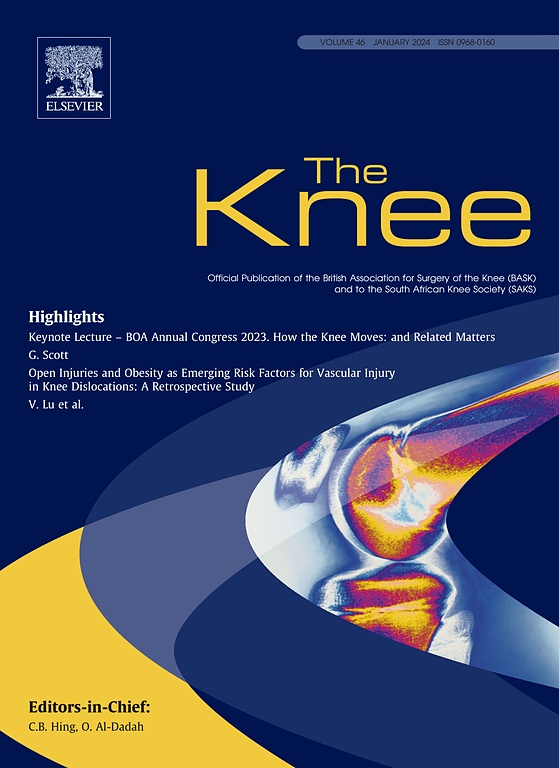
Femoral tunnel increase smaller with interference screw versus cortical button fixation in ACLR

Femoral tunnel increase smaller with interference screw versus cortical button fixation in ACLR
Tunnel widening after ACL reconstruction with aperture screw fixation or all-inside reconstruction with suspensory cortical button fixation: Volumetric measurements on CT and MRI scans
Knee. 2017 Oct;24(5):1047-1054Did you know you're eligible to earn 0.5 CME credits for reading this report? Click Here
Synopsis
33 patients scheduled for ACL reconstruction were included in this study to compare the effects of different fixation methods on postoperative tunnel widening. Patients were randomized to reconstruction using aperture screw fixation or suspensory cortical button fixation. Tunnel volume was measured over a 6 month period using MRI and CT scans. The results at 6 months indicated no differences between the two groups for tibial tunnel volume (117.7+/-24.1% button group vs. 113.9+/-10.3% screw group (p=0.565)). While the femoral tunnel volume at 6 months was significantly greater in the button group (143.2+/-34.4%) compared to the screw group (119.8+/-19.2%) (p=0.023).
Was the allocation sequence adequately generated?
Was allocation adequately concealed?
Blinding Treatment Providers: Was knowledge of the allocated interventions adequately prevented?
Blinding Outcome Assessors: Was knowledge of the allocated interventions adequately prevented?
Blinding Patients: Was knowledge of the allocated interventions adequately prevented?
Was loss to follow-up (missing outcome data) infrequent?
Are reports of the study free of suggestion of selective outcome reporting?
Were outcomes objective, patient-important and assessed in a manner to limit bias (ie. duplicate assessors, Independent assessors)?
Was the sample size sufficiently large to assure a balance of prognosis and sufficiently large number of outcome events?
Was investigator expertise/experience with both treatment and control techniques likely the same (ie.were criteria for surgeon participation/expertise provided)?
Yes = 1
Uncertain = 0.5
Not Relevant = 0
No = 0
The Reporting Criteria Assessment evaluates the transparency with which authors report the methodological and trial characteristics of the trial within the publication. The assessment is divided into five categories which are presented below.
4/4
Randomization
3/4
Outcome Measurements
4/4
Inclusion / Exclusion
4/4
Therapy Description
4/5
Statistics
Detsky AS, Naylor CD, O'Rourke K, McGeer AJ, L'Abbé KA. J Clin Epidemiol. 1992;45:255-65
The Fragility Index is a tool that aids in the interpretation of significant findings, providing a measure of strength for a result. The Fragility Index represents the number of consecutive events that need to be added to a dichotomous outcome to make the finding no longer significant. A small number represents a weaker finding and a large number represents a stronger finding.
Why was this study needed now?
Anterior cruciate ligament (ACL) reconstruction is often undergone following a tear. Various methods of graft fixation are available in these procedures. Recently, there has been an interest in whether the type of graft fixation used influences widening of either the femoral or tibial bone tunnels.
What was the principal research question?
In ACL reconstruction, does change in tunnel volume after 6 months significantly differ between graft fixation with bioabsorbable interference screws and suspensory extra-cortical button fixation?
What were the important findings?
- On MRI, the percent change in tibial tunnel volume from baseline to 6 months did not significantly differ between the button group (96.4+/-19.0%) and the screw group (108.0+/-14.9%) (p=0.060). Similarly, on CT, the percent change in tibial tunnel volume from baseline to 6 months did not significantly differ between the button group (117.7+/-24.1%) and the screw group (113.9+/-10.3%) (p=0.565).
- On MRI, the percent change in femoral tunnel volume from baseline to 6 months was significantly greater in the button group (154.3+/-38.0%) compared to the screw groups (110.9+/-20.7%) (p<0.001). Similarly, on CT, the percent change in tibial tunnel volume from baseline to 6 months was significantly greater in the button group (143.2+/-34.4%) compared to the screw group (119.8+/-19.2%) (p=0.023).
What should I remember most?
In ACL reconstruction, graft fixation with adjustable-length loop cortical buttons demonstrated significantly greater femoral tunnel volume increase within the first 6 months after surgery when compared to fixation with absorbable interference screws. Both types of fixation demonstrated similar degrees of tibial tunnel volume increase in the first 6 months after surgery.
How will this affect the care of my patients?
The results of this study suggest that short-term enlargement of the femoral tunnel may be larger with the use of an adjustable-length loop cortical button as opposed to a bioabsorbable interference screw in ACL reconstruction. Nevertheless, there is still considerable debate on the correlation between tunnel widening and clinical outcomes in these cases. Follow-up studies over the longer term are needed to determine if early tunnel enlargement is associated with latent complications after ACL reconstruction.
Learn about our AI Driven
High Impact Search Feature
Our AI driven High Impact metric calculates the impact an article will have by considering both the publishing journal and the content of the article itself. Built using the latest advances in natural language processing, OE High Impact predicts an article’s future number of citations better than impact factor alone.
Continue



 LOGIN
LOGIN

Join the Conversation
Please Login or Join to leave comments.
Orthopaedic Surgeon - Canada
A very useful study for my practice
Orthopaedic Surgeon - Canada
interesting
Orthopaedic Surgeon - United States
When screw starts to reabsorb, the tunnel diameter may enlarge. So need to know longer term data